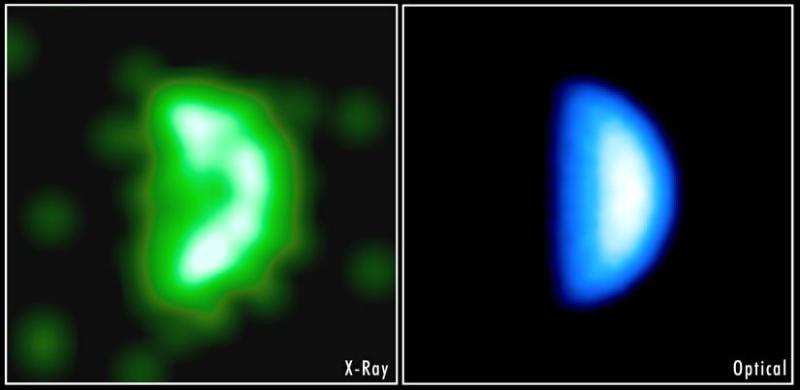Explanation: Venus, second planet from the Sun, appears above imaged for the first time ever in x-rays (left) by the orbiting Chandra Observatory. Chandra's smoothed, false-color, x-ray view is compared to an optical image (right) from a small earthbound telescope. Both show Venus illuminated by the Sun from the right, with only half the sunward hemisphere visible, but at least one striking difference is apparent. While the optical image in reflected sunlight is filled and bright at the center, Venus in x-rays is bright around the edge. Venus' x-rays are produced by fluorescence rather than reflection. About 120 kilometers or so above the surface, incoming solar x-rays excite atoms in the Venusian atmosphere to unstable energy levels. As the atoms rapidly decay back to their stable ground states they emit a "fluorescence" x-ray, creating a glowing x-ray half-shell above the sunlit hemisphere. More x-ray emitting material can be seen looking at the edge of the shell, so the edge appears brighter in the x-ray image.
1999 2000 2001 2002 2003 2004 2005 2006 2007 2008 2009 2010 2011 2012 2013 2014 2015 2016 2017 2018 2019 2020 2021 2022 2023 2024 2025 |
Yanvar' Fevral' Mart Aprel' Mai Iyun' Iyul' Avgust Sentyabr' Oktyabr' Noyabr' Dekabr' |
NASA Web Site Statements, Warnings, and Disclaimers
NASA Official: Jay Norris. Specific rights apply.
A service of: LHEA at NASA / GSFC
& Michigan Tech. U.
|
Publikacii s klyuchevymi slovami:
fluorescence - fluorescenciya - rentgenovskie luchi - Venera - Venus
Publikacii so slovami: fluorescence - fluorescenciya - rentgenovskie luchi - Venera - Venus | |
Sm. takzhe:
Vse publikacii na tu zhe temu >> | |
